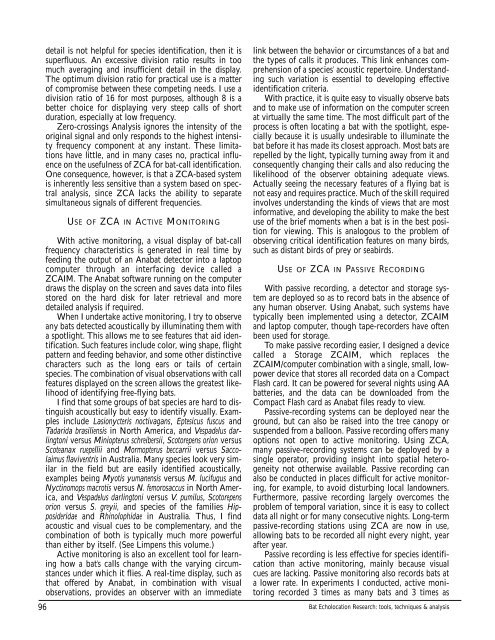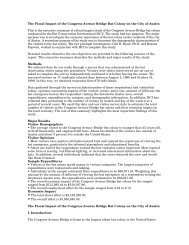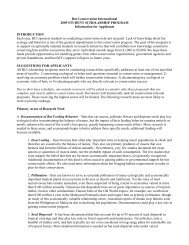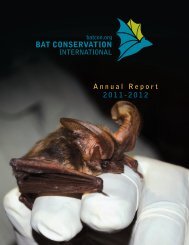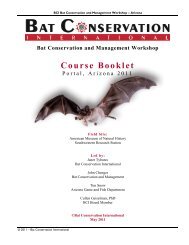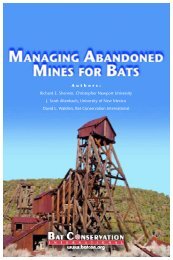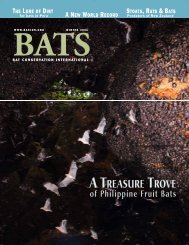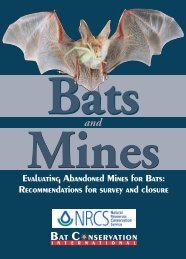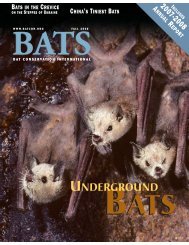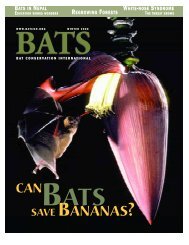Bat Echolocation Researc h - Bat Conservation International
Bat Echolocation Researc h - Bat Conservation International
Bat Echolocation Researc h - Bat Conservation International
Create successful ePaper yourself
Turn your PDF publications into a flip-book with our unique Google optimized e-Paper software.
96<br />
detail is not helpful for species identification, then it is<br />
superfluous. An excessive division ratio results in too<br />
much averaging and insufficient detail in the display.<br />
The optimum division ratio for practical use is a matter<br />
of compromise between these competing needs. I use a<br />
division ratio of 16 for most purposes, although 8 is a<br />
better choice for displaying very steep calls of short<br />
duration, especially at low frequency.<br />
Zero-crossings Analysis ignores the intensity of the<br />
original signal and only responds to the highest intensity<br />
frequency component at any instant. These limitations<br />
have little, and in many cases no, practical influence<br />
on the usefulness of ZCA for bat-call identification.<br />
One consequence, however, is that a ZCA-based system<br />
is inherently less sensitive than a system based on spectral<br />
analysis, since ZCA lacks the ability to separate<br />
simultaneous signals of different frequencies.<br />
USE OF ZCA IN ACTIVE MONITORING<br />
With active monitoring, a visual display of bat-call<br />
frequency characteristics is generated in real time by<br />
feeding the output of an Anabat detector into a laptop<br />
computer through an interfacing device called a<br />
ZCAIM. The Anabat software running on the computer<br />
draws the display on the screen and saves data into files<br />
stored on the hard disk for later retrieval and more<br />
detailed analysis if required.<br />
When I undertake active monitoring, I try to observe<br />
any bats detected acoustically by illuminating them with<br />
a spotlight. This allows me to see features that aid identification.<br />
Such features include color, wing shape, flight<br />
pattern and feeding behavior, and some other distinctive<br />
characters such as the long ears or tails of certain<br />
species. The combination of visual observations with call<br />
features displayed on the screen allows the greatest likelihood<br />
of identifying free-flying bats.<br />
I find that some groups of bat species are hard to distinguish<br />
acoustically but easy to identify visually. Examples<br />
include Lasionycteris noctivagans, Eptesicus fuscus and<br />
Tadarida brasiliensis in North America, and Vespadelus darlingtoni<br />
versus Miniopterus schreibersii, Scotorepens orion versus<br />
Scoteanax ruepellii and Mormopterus beccarrii versus Saccolaimus<br />
flaviventris in Australia. Many species look very similar<br />
in the field but are easily identified acoustically,<br />
examples being Myotis yumanensis versus M. lucifugus and<br />
Nyctinomops macrotis versus N. femorosaccus in North America,<br />
and Vespadelus darlingtoni versus V. pumilus, Scotorepens<br />
orion versus S. greyii, and species of the families Hipposideridae<br />
and Rhinolophidae in Australia. Thus, I find<br />
acoustic and visual cues to be complementary, and the<br />
combination of both is typically much more powerful<br />
than either by itself. (See Limpens this volume.)<br />
Active monitoring is also an excellent tool for learning<br />
how a bat’s calls change with the varying circumstances<br />
under which it flies. A real-time display, such as<br />
that offered by Anabat, in combination with visual<br />
observations, provides an observer with an immediate<br />
link between the behavior or circumstances of a bat and<br />
the types of calls it produces. This link enhances comprehension<br />
of a species’ acoustic repertoire. Understanding<br />
such variation is essential to developing effective<br />
identification criteria.<br />
With practice, it is quite easy to visually observe bats<br />
and to make use of information on the computer screen<br />
at virtually the same time. The most difficult part of the<br />
process is often locating a bat with the spotlight, especially<br />
because it is usually undesirable to illuminate the<br />
bat before it has made its closest approach. Most bats are<br />
repelled by the light, typically turning away from it and<br />
consequently changing their calls and also reducing the<br />
likelihood of the observer obtaining adequate views.<br />
Actually seeing the necessary features of a flying bat is<br />
not easy and requires practice. Much of the skill required<br />
involves understanding the kinds of views that are most<br />
informative, and developing the ability to make the best<br />
use of the brief moments when a bat is in the best position<br />
for viewing. This is analogous to the problem of<br />
observing critical identification features on many birds,<br />
such as distant birds of prey or seabirds.<br />
USE OF ZCA IN PASSIVE RECORDING<br />
With passive recording, a detector and storage system<br />
are deployed so as to record bats in the absence of<br />
any human observer. Using Anabat, such systems have<br />
typically been implemented using a detector, ZCAIM<br />
and laptop computer, though tape-recorders have often<br />
been used for storage.<br />
To make passive recording easier, I designed a device<br />
called a Storage ZCAIM, which replaces the<br />
ZCAIM/computer combination with a single, small, lowpower<br />
device that stores all recorded data on a Compact<br />
Flash card. It can be powered for several nights using AA<br />
batteries, and the data can be downloaded from the<br />
Compact Flash card as Anabat files ready to view.<br />
Passive-recording systems can be deployed near the<br />
ground, but can also be raised into the tree canopy or<br />
suspended from a balloon. Passive recording offers many<br />
options not open to active monitoring. Using ZCA,<br />
many passive-recording systems can be deployed by a<br />
single operator, providing insight into spatial heterogeneity<br />
not otherwise available. Passive recording can<br />
also be conducted in places difficult for active monitoring,<br />
for example, to avoid disturbing local landowners.<br />
Furthermore, passive recording largely overcomes the<br />
problem of temporal variation, since it is easy to collect<br />
data all night or for many consecutive nights. Long-term<br />
passive-recording stations using ZCA are now in use,<br />
allowing bats to be recorded all night every night, year<br />
after year.<br />
Passive recording is less effective for species identification<br />
than active monitoring, mainly because visual<br />
cues are lacking. Passive monitoring also records bats at<br />
a lower rate. In experiments I conducted, active monitoring<br />
recorded 3 times as many bats and 3 times as<br />
<strong>Bat</strong> <strong>Echolocation</strong> <strong>Researc</strong>h: tools, techniques & analysis


